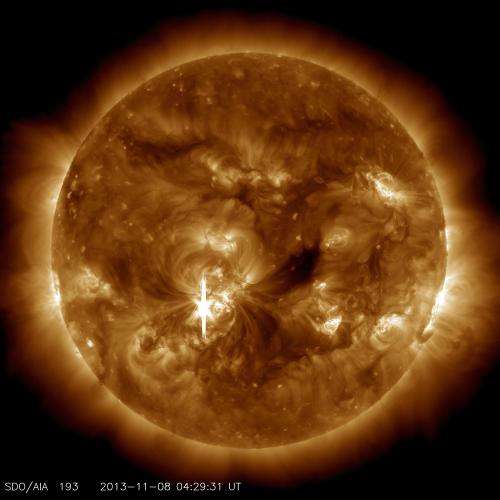NASA's Solar Dynamics Observatory captured this image of the sun showing an X1.1 class flare that peaked at 11:26 p.m. EST on Nov. 7, 2013. Increased numbers of flares are quite common at the moment as the sun's normal 11-year activity cycle is ramping up toward solar maximum conditions. Credit: NASA/SDO
The sun emitted its sixth significant flare since Oct. 23, 2013, peaking at 11:26 p.m. EST on Nov. 7, 2013. Solar flares are powerful bursts of radiation. Harmful radiation from a flare cannot pass through Earth's atmosphere to physically affect humans on the ground, however—when intense enough—they can disturb the atmosphere in the layer where GPS and communications signals travel.
To see how this event may affect Earth, please visit NOAA's Space Weather Prediction Center, the U.S. government's official source for space weather forecasts, alerts, watches and warnings.
This flare is classified as an X1.1 flare. X-class denotes the most intense flares, while the number provides more information about its strength. An X2 is twice as intense as an X1, an X3 is three times as intense, etc.
Increased numbers of flares are quite common at the moment, because the sun's normal 11-year activity cycle is ramping up toward solar maximum conditions. Humans have tracked this solar cycle continuously since it was discovered in 1843, and it is normal for there to be many flares a day during the sun's peak activity. The first X-class flare of the current solar cycle occurred on Feb. 15, 2011. The largest X-class flare in this cycle was an X6.9 on Aug. 9, 2011.
Provided by NASA's Goddard Space Flight Center























